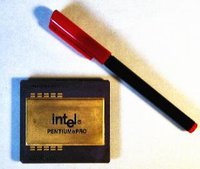Pentium Pro
|
|
The Pentium Pro is a sixth-generation x86 architecture microprocessor by Intel originally intended to replace the original Pentium in a full range of applications, but later reduced to a more narrow role as a server and high-end desktop chip. It was introduced using an enormous rectangular Socket 8 form factor in November 1995. Intel has since discontinued it in favor of the newer high-end Xeon processor lines.
Despite the name, the Pentium Pro is actually quite different from Intel's earlier Pentium processor, being based on the then-new P6 core (which in a modified form would later be used for the Pentium II, Pentium III and Pentium M). The P6 core features out-of-order execution, speculative execution, and an additional pipe for simple instructions.
Pentium_pro.jpg
Speculative execution — the provisional execution of code in a branch that is not yet certain to be taken — considerably increases the penalty for mispredicting a branch, and the Pentium Pro therefore uses a more sophisticated branch prediction algorithm than the Pentium. For the same reason, the Pentium Pro also introduced a conditional move (cmov) instruction which in some cases can be used to avoid the need for a branch instruction altogether. Performance with 32-bit code was excellent; however, the Pentium Pro often ran slower than a vanilla Pentium when running 16-bit code and operating systems. It was this that caused the rather lackluster reception for the chip among many home PC enthusiasts, given the dominance at the time of the 16-bit Windows 3.1. Windows 95 had already been released at the time of the introduction of the Pentium Pro, but Microsoft Windows applications and some parts of Windows 95 itself were still mostly 16-bit.
The Pentium Pro had a 256K-512K on-package cache at introduction, with a 1 MB version introduced later. All versions of the chip were expensive, those with more than 256K being particularly so. The Pro's "on-package cache" arrangement was unique. The processor and the cache were on separate dies in the same package and connected closely by a full-speed bus. The two dies — both of which were very large by the standards of the day — had to be bonded together early in the production process, before testing was possible. This meant that a single, tiny flaw in either die made it necessary to discard the entire assembly, which was one of the reasons for the Pentium Pro's relatively low production yield and high cost.
Following discussions of future product planning with Microsoft, Intel made the design decision to optimise the Pentium Pro for 32-bit code. In consequence it performed poorly on 16-bit code, and when Windows 95 turned out to be largely 16-bit, the Pro was not well positioned to compete in the desktop market. Introduced as a high-end server and workstation chip for the 32-bit Windows NT and UNIX operating systems, it was now destined to stay within that market rather than migrate onto the home desktop. Intel filled the gap with an improvement to the older Pentium Classic design called the Pentium MMX.
Pentium Pro clock speeds were 150, 166, 180 or 200 MHz with a 60 or 66 MHz external bus clock. Many users chose to overclock their Pentium Pro chips, with the 200 MHz version often being run at 233 MHz, and the 150 MHz version often being run at 166 MHz. The chip was popular in symmetric multiprocessing configurations, with dual and quad SMP server and workstation setups being commonplace. Many of the Pentium Pro systems that were produced are still employed today for those purposes.
The Pentium Pro was succeeded by the Pentium II, which was essentially an improved and re-branded Pentium Pro with the addition of MMX and enhanced 16-bit code performance. A 333 MHz Pentium II processor for Socket 8 was produced by Intel as an upgrade option for owners of Pentium Pro systems.
| Missing image List of Intel microprocessors | List of Intel CPU slots, sockets
IntelLogo.png |
|
4004 | 4040 | 8008 | 8080 | 8085 | 8086 | 8088 | iAPX 432 | 80186 | 80188 | 80286 | 80386 | 80486 | i860 | i960 | Pentium | Pentium Pro | Pentium II | Celeron | Pentium III | Pentium 4 | Pentium M | Pentium D | Pentium Extreme Edition | Xeon | Itanium | Itanium 2 (italics indicate non-x86 processors) |
fr:Pentium Pro pl:Pentium Pro fi:Intel Pentium Pro es:Intel Pentium Pro ja:Pentium Pro

